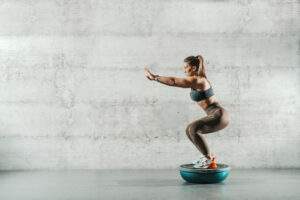Human Pose Estimation Challenges in AI-Powered Fitness apps
Fitness is the new trend and with more and more people becoming aware of the importance of staying healthy and fit, fitness apps have seen a tremendous boom. According to the Wellness Creatives report, the fitness industry is making a revenue growth of 8.7% every year and the fitness applications are the catalyst of this growth.
Technology has taken over our lives so much that we find ourselves struggling without it. In the fitness sector, technology is changing how we saw health in the past. From tracking our daily movement, adjusting our nutrition chart based on our exercise activity, we find AI making our fitness journey easier every day. Fitness app development companies are bringing more personalized experience to their fitness apps through AI.
The use of AI in Fitness App development is aimed to make the applications more interactive and user-friendly. One of the many benefits of applying AI in fitness app development is the human pose estimation. It refers to the technology where computer vision-based technology is used to detect and process human postures with human body modeling at the core of the technology. It works on the orientation and position of the human body.
Let’s understand how human pose estimation works
AI-based fitness apps help users to perform exercises correctly and maintain the right posture. The AI makes it interactive and personalized. A pose estimation algorithm uses an image of the user as input and gives output showing the landmarks on the human body and coordinates of specific key points. These advanced pose estimation algorithms are powered by convolutional neural networks and hourglass architecture and its variants.
It consists of two major parts: a convolutional encoder that compresses the image provided as the input to a latent representation and a decoder that builds N heat maps from it. N is the number of searched key points in the human body structure. A single heat map, given as the output, is a one-channel image with the same input resolution.
This technology is used efficiently in pose estimation by AI-based fitness app development companies through devices that are equipped with a camera. It follows the following algorithm in human pose estimation in fitness apps
- The camera of the device captures the movement during the exercise session and records a video through the app.
- The video is then split into individual frames. These frames are processed in line with the model of human pose estimation which detects key points on the human body and forms a virtual 2D/3D skeleton.
- With AI, the virtual skeleton is analyzed for mistakes in the body posture during the exercise based on the technique shown on the app.
- The user then receives recommendations to improve along with descriptions of the mistakes.
These steps seem to be simple but when it comes to developing this technology, a fitness app development company faces many challenges.
Let’s learn about the challenges of human pose estimation in the AI-powered fitness app development
Even with advanced technology in place, fitness apps are not perfect yet to answer all the questions about posture corrections. There are numerous challenges faced in the development of a perfect app. For example, squats, one of the most simple and effective exercises, is not performed correctly by many and often needs the assistance of a trainer to hold the correct posture, specially with weights. Can AI replace the need for the trainer during squats? Will it be able to make the right exercise estimation as a trainer does? Here are some such challenges of human pose estimation.
Different body specifics of men and women
There is a big difference in the body posture of men and women. It is important to consider the physiological difference between men’s and women’s bodies. If the model is trained using men’s image, it may fail to give the right output to women due to the difference in men’s and women’s bodies.
Different physiology specifications
Every human body has different proportions. Torso, arms, legs, every body part is disproportionate. AI in fitness app development needs to be capable of analyzing the different body specifications of different users.
Front view error
The AI in fitness app development makes a comparison of the data from the reference videos which show the right technique of the exercise and the input video of the user. The AI then analyzes the performance to give output for the correct posture. To get accurate results, the 3D key points of both the videos must align and compare the user joints with that of the athletes.
The issue arises when the user uses the front view, the pose estimation model fails to produce high-quality results. This is because the training datasets of this model lack enough images of movements. Fitness app development companies also face problems with horizontal positions and occluded joints.
Lower body quick movements
AI-powered fitness apps also struggle to produce results in the case of exercises apart from squats like kicks in martial arts. The pose estimation model might not catch the fast transition movement of the martial art kick. Another reason for this could be the lack 2D keypoint dataset of such limb images.
These are just a few challenges that AI powered fitness apps face for making correct human posture estimation. The lack of accuracy also comes from the application not being able to keep up with the human movement when used on mobile. AI in fitness app development can bring a revolution but it is required to produce more accurate results. Fitness app development companies will need more diverse data to train the model properly about human body movements and maybe then it will be able to make more accurate and precise estimations about human postures.






